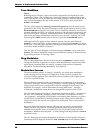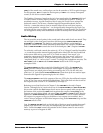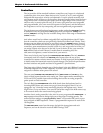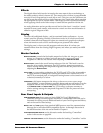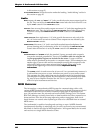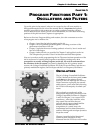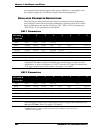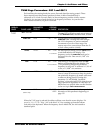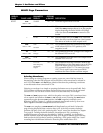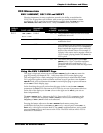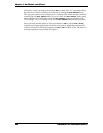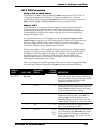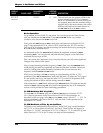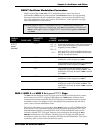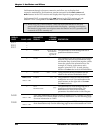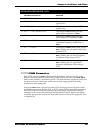
Chapter 5: Oscillators and Filters
106 ANDROMEDA A6 REFERENCE MANUAL
WAVE Page Parameters
DISPLAY
PAGE PANEL LABEL
PARAMETER
DISPLAY
OPTIONS
or RANGE
DESCRIPTION
WAVE
SQR
Button + LED
SQUARE OFF, ON
Turns the Square Wave on or off.
PULSE WIDTH WIDTH 0 ··· 100
This parameter sets the width of the Square Wave.
When the
SQR parameter above is on, the graphic
display depicting the Pulse Width will change
when you turn the
PULSE WIDTH control or soft
knob
2.
— LEVEL
0 ··· 100
Sets the output level of the SQR wave. Note that
this is the only waveform that has a level control.
The others are either on (full output) or off.
SAW
Button + LED
SAW
Sawtooth
OFF,
POS,
NEG
This parameter turns the Sawtooth wave output
of the selected VCO to
POS (positive), NEG
(negative) or off.
TRI
Button + LED
TRI
Triangle
OFF, ON
This parameter turns the Triangle wave output of
the selected VCO on or off.
SINE
Button + LED
SINE OFF, ON
This parameter turns the Sine wave output of the
selected VCO on or off.
—
FILTFM
Filter Frequency
Modulation
Output
OFF, ON
This parameter turns the oscillator's send to the
FM modulation of the filter section on or off. This
Filter FM output goes to the Filter section's
CV
SRC
parameter as the FILTFM source (see page
129). This is used if you want to use FM to
modulate the filter with the oscillator output.
Selecting Waveforms
When editing an existing Program or creating a new one, one of the key issues in
determining what the final program will sound like is what waveform is selected in
each VCO. Both
OSC 1 and OSC 2 have identical functions for producing waveforms
so our discussion here covers both VCOs.
Selecting a waveform is as simple as pressing the button next to its panel label. Each
VCO can have a different waveform and more than one waveform can be activated
on each VCO. You can have all four waves on at the same time, for example.
The
SAW and SQR (square wave, which is the pulse wave set to 50%) waveforms have
a few controls not found on the
SINE or TRI (triangle wave). Pressing the SAW button
repeatedly toggles between
POS (positive) and NEG (negative) sawtooth waves.
Referring again to Chapter 3, a positive sawtooth corresponds to the Up Saw wave
and a negative sawtooth corresponds to the Down Saw.
The
SQR wave employs a PULSE WIDTH knob (duplicated on soft knob 2 when this
page is being displayed) that varies its duty cycle. At its fully counter-clockwise
position, the duty cycle is 0% producing that “nasal” sound we described in Chapter
3 on page 83. Turning the knob clockwise, the midpoint is 50%, producing a
traditional square wave that we described as “hollow” sounding. As the knob is
turned clockwise from the midpoint, the duty cycle begins to narrow again until the
knob reaches its full clockwise position, producing a 100% pulse width, also “nasal”
sounding but with different harmonics than the pulse widths below 50%.



